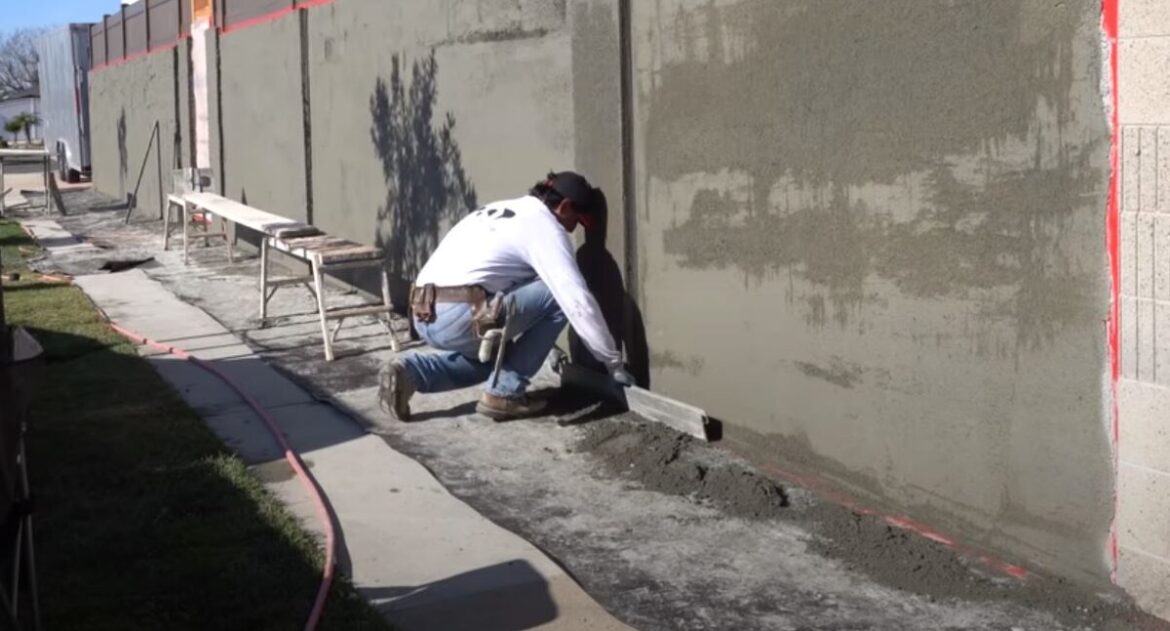What are the Thermal Benefits of Stucco? Unpacking the Insulating Power of Plaster
The Science Behind Stucco
Stucco, a durable plaster, has roots that can be traced back centuries, being used in everything from ancient homes to modern edifices. Comprising lime, sand, and water, this plaster offers more than just a visual appeal; it’s an unsung hero in thermal insulation. At the molecular level, stucco’s composition lends itself to be an excellent thermal barrier.
Stucco’s Thermal Capacities
Heat Retention and Release:
One of the primary reasons stucco is favoured, especially in areas with varying temperatures, is its ability to regulate heat. The porous nature of stucco allows it to absorb a significant amount of external heat during the hotter months, preventing a sudden spike in indoor temperatures. This absorption acts as a buffer, preventing the external heat from overwhelming a home’s interior. Conversely, during colder months, stucco proves its mettle by retaining indoor heat. Its dense composition minimises the escape of warmth, ensuring homes, even in the cooler pockets of Ponsonby, remain snug and comfortable.
Energy Efficiency:
With rising energy costs and a global push towards sustainability, the energy efficiency of building materials has never been more critical. Stucco’s insulating properties play a pivotal role in reducing the strain on heating and cooling systems. When homes are insulated with stucco, the reduced need for artificial temperature control leads to significant energy savings. Over the long term, this can lead to noticeable reductions in energy bills, making stucco not just an eco-friendly choice but also an economically wise one.
Thermal Mass and Its Implications:
The concept of thermal mass refers to a material’s ability to store heat energy. Materials with high thermal mass can absorb, store, and later release significant amounts of heat. Stucco, with its dense composition, has a high thermal mass. This characteristic means that during hot days, stucco can absorb and store the sun’s heat, releasing it gradually during the cooler nighttime, thus stabilising indoor temperatures. Similarly, during colder days, it can retain indoor warmth, gradually releasing it to counteract the dropping temperatures outside.
Consistent Temperatures:
Beyond the immediate benefits of heat regulation, stucco also ensures a consistent indoor temperature. Fluctuating temperatures can lead to discomfort, increased energy consumption, and even health concerns. Stucco’s insulating properties create a stable indoor climate, eliminating sharp temperature spikes or drops. For residents of areas like Grey Lynn, where microclimates can mean a chilly morning turns into a warm afternoon, this consistency proves invaluable.
Stucco vs. Other Plastering Techniques
Stucco stands out in the plastering world for its distinctive appearance and the unique thermal benefits it offers. However, how does it measure up against other plastering techniques in terms of performance, aesthetic appeal, and overall value? Let’s take a closer look.
- Stucco vs. Lime Plaster:
-
- Composition: Lime plaster, predominantly made from a mixture of lime, sand, and water, has been a staple in construction for millennia. Stucco, on the other hand, involves a combination of lime, sand, and cement, offering additional strength and durability.
- Thermal Benefits: Lime plaster is relatively breathable, allowing moisture to evaporate quickly. However, stucco offers superior thermal regulation due to its density and ability to retain and release heat efficiently.
- Aesthetic: While both can achieve a smooth finish, stucco provides more texture variety and can be moulded to mimic other materials, lending versatility to architectural designs. Lime plaster offers a classic, timeless look, particularly popular in heritage properties across Parnell.
- Stucco vs. Gypsum Plaster:
-
- Composition: Gypsum plaster is primarily composed of gypsum powder mixed with water. It sets quickly and is primarily used for interiors.
- Thermal Benefits: While gypsum is a good insulator, stucco surpasses it in terms of thermal mass, making stucco more efficient in maintaining consistent internal temperatures.
- Aesthetic: Gypsum plaster provides a silky, smooth finish ideal for interiors, especially in places like Mount Eden where residents often aim for a modern, sleek look. Stucco, conversely, offers a textured, rugged finish that’s more suited for exteriors.
- Stucco vs. Venetian Plaster:
-
- Composition: Venetian plaster contains lime, marble dust, and pigments, delivering a polished marble-like appearance.
- Thermal Benefits: Both stucco and Venetian plaster provide good insulation. However, stucco’s robustness and density make it slightly more efficient in temperature regulation.
- Aesthetic: Venetian plaster offers a high sheen, reflective finish that can imitate the opulence of marble, making it a favourite for luxurious properties in upscale Auckland suburbs. Stucco is more versatile, suitable for a range of property styles, from rustic to contemporary.
Comparison Table:
| Criteria | Stucco | Lime Plaster | Gypsum Plaster | Venetian Plaster |
| Composition | Lime, sand, and cement | Lime, sand, and water | Gypsum powder mixed with water | Lime, marble dust, and pigments |
| Thermal Benefits | Superior thermal regulation due to density | Breathable, allows moisture to evaporate | Good insulator but less efficient than stucco | Good insulation, slightly less efficient than stucco |
| Aesthetic | Textured, rugged finish. Versatile for exteriors | Classic, timeless look | Silky, smooth finish ideal for interiors | High sheen, reflective finish mimicking marble |
| Popular in Suburb | Versatile for various Auckland properties | Heritage properties in Parnell | Modern interiors in Mount Eden | Luxurious properties in upscale Auckland suburbs |
Safety and Potential Risks with Stucco
Any construction material comes with its set of precautions. When working with stucco:
- Inhalation Hazards: The fine particles in stucco mix can pose respiratory risks if inhaled. Always use masks and ensure well-ventilated working conditions.
- Skin Contact: Wet stucco can cause skin irritation. It’s essential to wear gloves during application and wash any skin that comes into contact immediately.
- Structural Concerns: Incorrectly applied stucco can lead to cracks, potentially compromising the building’s structural integrity, especially in areas that experience shifts in ground levels, like Grey Lynn.
How Aucklanders are Benefiting from Stucco’s Thermal Properties
It’s no secret that Aucklanders are reaping the benefits of stucco’s thermal properties. Not only does it offer an aesthetically pleasing finish, but its insulation prowess ensures homes remain temperate year-round, making it a popular choice in Auckland’s varied climatic conditions.
Engaging Expertise: The Value of Professional Application
While the benefits of stucco are manifold, its potential is maximised when applied by experts. “Your Plasterers Auckland” emerge as leaders in the field, offering impeccable stucco application, ensuring homes not only look great but are also thermally efficient.
A Look into the Future: Stucco’s Evolution
Research continues into enhancing stucco’s already impressive properties. New compositions, integrating materials like aerogels, aim to push the boundaries of stucco’s insulating capabilities even further.
So, as we delve deep into the science behind stucco, it’s evident that its thermal benefits are just one of the many reasons it remains a staple in construction, both in historical contexts and contemporary settings. For those considering a plastering overhaul, stucco stands out as a choice worth considering.
Frequently Asked Questions (FAQs)
What exactly is stucco made of?
Stucco is primarily composed of lime, sand, and cement, mixed with water to create a consistent plaster.
How does stucco provide better thermal regulation?
Stucco possesses a dense nature which allows it to effectively regulate indoor temperatures. It acts as a barrier to heat during hot weather and retains indoor warmth during colder months.
Is stucco suitable for both interiors and exteriors in Auckland?
Absolutely! Stucco is versatile and can be applied to both interior and exterior surfaces. However, its robust and weather-resistant nature makes it especially popular for exteriors in areas like Remuera.
How does stucco compare to other plastering techniques in terms of longevity?
Stucco is renowned for its durability. With proper maintenance, stucco finishes can last for many decades, outlasting some other plastering options.
Are there any health and safety risks associated with stucco?
Like any plastering technique, the application process can produce dust which might be harmful when inhaled. It’s essential that professionals use protective gear and ensure the site is well-ventilated. Once applied and dried, stucco poses no health risks.
Can stucco be painted or tinted?
Yes, stucco can be tinted during the mixing process or painted over once it has dried and cured. It offers a porous surface which can hold paint effectively.
What maintenance does stucco require?
Stucco requires minimal maintenance. Periodic cleaning and inspection for cracks or damages will ensure its longevity. If cracks appear, they should be addressed promptly to maintain its thermal benefits and appearance.
Is stucco more expensive than other plastering techniques?
While the initial cost of stucco might be higher than some other plastering techniques due to its composition and application process, its longevity and minimal maintenance requirements often make it cost-effective in the long run.
How does the Auckland climate affect stucco?
Auckland’s temperate climate is generally suitable for stucco. However, homes in coastal areas like Takapuna may require additional sealants to protect the stucco from salt and moisture exposure.
Can I apply stucco myself or should I engage a professional?
While DIY stucco kits are available, for best results and to ensure the thermal benefits are optimised, it’s recommended to engage professionals, such as Your Plasterers Auckland. They possess the expertise and equipment to ensure a perfect finish.
Key Takeaways
- Thermal Regulation: Stucco acts as an efficient thermal barrier, helping to keep interiors cool during hot months and warm during colder periods.
- Versatility: Suitable for both interiors and exteriors, stucco’s robust and weather-resistant nature makes it particularly beneficial for external applications in Auckland regions like Remuera.
- Longevity: With proper maintenance, stucco can outlast many other plastering methods, proving its durability over time.
- Safety and Health: While stucco application involves some health considerations, such as dust inhalation, once applied and cured, it poses no health risks. Proper safety measures during the application can mitigate risks.
- Aesthetic Flexibility: Stucco can be tinted during the mixing phase or painted post-application, allowing homeowners to customize the appearance to their liking.
- Minimal Maintenance: Beyond periodic cleaning and inspections for damages, stucco requires little to no additional maintenance.
- Cost-Effectiveness: The initial investment in stucco might be higher than some plastering alternatives, but its durability and low maintenance often render it more cost-effective over time.
- Climate Compatibility: Stucco is well-suited for Auckland’s temperate climate, but coastal regions such as Takapuna might require additional precautions to combat salt and moisture.
- Professional Recommendation: To maximize the benefits of stucco, especially its thermal properties, it’s advised to engage plastering professionals like Your Plasterers Auckland for its application.
- Comparison: Compared to other plastering techniques, stucco offers superior thermal benefits, making it a preferred choice for many homeowners seeking energy efficiency and comfort.
References
- Building Performance – “External Plastering Systems.” A comprehensive guide provided by New Zealand’s Ministry of Business, Innovation & Employment, detailing the requirements for exterior plaster systems.
- Auckland Council – “Building and construction specifications in Auckland.” A resource that outlines the construction standards and materials suitable for Auckland’s unique climate and conditions.
- BRANZ (Building Research Association of New Zealand) – “Stucco as an Effective Thermal Barrier.” An in-depth study on the thermal capacities of stucco in New Zealand homes.
- Engineers New Zealand – “The Science Behind Stucco.” A publication exploring the technical aspects and advantages of using stucco as a plastering method.
- NZ Standards – “NZS 4251.1:2007 Solid Plastering – Plaster materials.” A standard detailing the materials to be used in solid plastering, including stucco.

